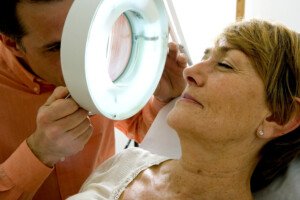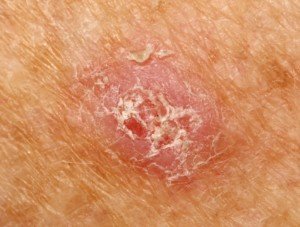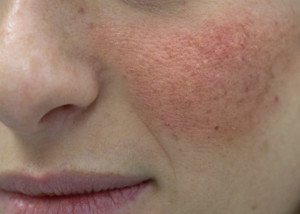
A flaky dry patch on your forehead might be a precursor to skin cancer, says Kally Papantoniou, MD, FAAD, with Simply Dermatology in NY.
But it can also be a benign condition called seborrheic dermatitis.
Precursor to Skin Cancer: Flaky Dry Patch on Forehead
The forehead can get a lot of sun in a person’s first 18 years of life.
“Flaky dry patches on the forehead can be from chronic sun damage which occurred many years ago, and these look like skin colored to pink or brown rough patches that feel like sand paper,” explains Dr. Kally.
“These are called actinic keratoses, which occur from precancerous changes, and should not be ignored because 1 percent or more may progress to a skin cancer.”
But not melanoma. The type of cancer that an AK can morph into is called squamous cell carcinoma.

Squamous cell carcinoma. Shutterstock/Dermatology11
The good news is that AKs grow very slowly, and most SCCs grow slowly, too, though if left untreated, will spread to other sites in the body and can be fatal.
Estimates for what percentage of untreated AKs transform into malignancies vary, but the estimated figure never exceeds 10 percent.

Actinic keratoses
A dermatologist may diagnose an actinic keratosis simply by rubbing a fingertip over it to detect its classic sandpaper feel.
The actinic keratoses that you get at age 45 were probably set in motion during childhood sun exposure.
AKs “can be prevented with regular use of sunscreen and photoprotection, and can be treated with cryotherapy [liquid nitrogen spray], creams and light treatments,” says Dr. Kally.
Benign Cause of Flay Dry Patch on Forehead
As mentioned, condition called seborrheic dermatitis can cause a patch on the forehead that’s flaky and that seems dry.
I myself had one of these, between the eyebrows where the skin is oilier.
One big difference between seborrheic dermatitis and actinic keratosis is that the former typically itches or has a slight burning or stinging to it — especially if it’s on the nose or nostrils.
Another sign that points to seborrheic dermatitis is that it flakes much more than an AK.
Finally, a seborrheic dermatitis flare will often have a vague orange or salmon colored tinge to it, while an AK usually is on the spectrum of pure pink or light magenta.
Do not self-diagnose your dry flaky forehead patch. A dermatologist can easily do this.
Dr. Papantoniou is a board certified dermatologist specializing in cosmetic, laser and surgical dermatology.
is a board certified dermatologist specializing in cosmetic, laser and surgical dermatology.
 Lorra Garrick has been covering medical, fitness and cybersecurity topics for many years, having written thousands of articles for print magazines and websites, including as a ghostwriter. She’s also a former ACE-certified personal trainer.
Lorra Garrick has been covering medical, fitness and cybersecurity topics for many years, having written thousands of articles for print magazines and websites, including as a ghostwriter. She’s also a former ACE-certified personal trainer.
.


























